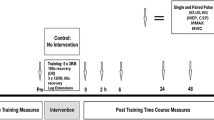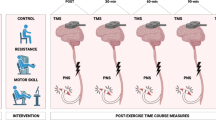Abstract
This study used transcranial magnetic stimulation to measure the corticospinal responses following 8 weeks of unilateral leg strength training. Eighteen healthy, non-strength trained participants (14 male, 4 female; 18–35 years of age) were matched for age, gender, and pre-training strength; and assigned to a training or control group. The trained group participated in unilateral horizontal leg press strength training, progressively overloaded and wave periodised, thrice per week for 8 weeks. Testing occurred prior to the intervention, at the end of 4 weeks and at the completion of training at 8 weeks. Participants were tested in both legs for one repetition maximum strength, muscle thickness, maximal electromyography (EMG) activity, and corticospinal excitability and inhibition. No changes were observed in muscle thickness in either leg. The trained leg showed an increase in strength of 21.2% (P = 0.001) and 29.0% (P = 0.007, compared to pre-testing) whilst the untrained contralateral leg showed 17.4% (P = 0.01) and 20.4% (P = 0.004, compared to pre-testing) increases in strength at 4 and 8 weeks, respectively. EMG and corticospinal excitability did not change; however, corticospinal inhibition was significantly reduced by 17.7 ms (P = 0.003) and 17.3 ms (P = 0.001) at 4 and 8 weeks, respectively, in the trained leg, and 25.1 ms (P = 0.001) and 20.8 ms (P = 0.001) at 4 and 8 weeks, respectively, in the contralateral untrained leg. This data support the theory of corticospinal adaptations underpinning cross-education gains in the lower limbs following unilateral strength training.




Similar content being viewed by others
References
Aagaard P (2003) Training-induced changes in neural function. Exerc Sports Sci Rev 31:61–67
Abe T, DeHoyos DV, Pollock ML, Garzarella L (2000) Time course for strength and muscle thickness changes following upper and lower body resistance training in men and women. Eur J Appl Physiol 81:174–180
Adamson M, MacQuaide N, Helgerud J, Hoff J, Kemi O (2008) Unilateral arm strength training improves contralateral peak force and rate of force development. Eur J Appl Physiol 103:553–559
Baechle TR, Earle R (2008) Essentials of strength training and conditioning. Human Kinetics, Champaign
Beck S, Taube W, Gruber M, Amtage F, Gollhofer A, Schubert M (2007) Task-specific changes in motor-evoked potentials of lower limb muscles after different training interventions. Brain Res 1179:51–60
Carolan B, Cafarelli E (1992) Adaptations in coactivation after isometric resistance training. J Appl Physiol 73:911–917
Carroll TJ, Herbert RD, Munn J, Lee M, Gandevia SC (2006) Contralateral effects of unilateral strength training: evidence and possible mechanisms. J Appl Physiol 101:1514–1522
Chapman JP, Chapman LJ, Allen JJ (1987) The measurement of foot preference. Neuropsychologia 25:579–584
Chen R (2004) Interactions between inhibitory and excitatory circuits in the human motor cortex. Exp Brain Res 154:1–10
Chen R, Lozano AM, Ashby P (1999) Mechanism of the silent period following transcranial magnetic stimulation. Evidence from epidural recordings. Exp Brain Res 128:539–542
Chilibeck PD, Calder AW, Sale DG, Webber CE (1998) A comparison of strength and muscle mass increases during resistance training in young women. Eur J Appl Physiol 77:170–175
d’Avella A, Saltiel P, Bizzi E (2003) Combinations of muscle synergies in the construction of a natural motor behavior. Nat Neurosci 6:300–308
Davies CT, Dooley P, McDonagh MJ, White MJ (1985) Adaptation of mechanical properties of muscle to high force training in man. J Physiol 365:277–284
Del Balso C, Cafarelli E (2007) Adaptations in the activation of human skeletal muscle induced by short-term isometric resistance training. J Appl Physiol 103:402–411
Deutsch H, Lin DC (1978) Quadricep kinesiology (emg) with varying hip joint flexion and resistance. Arch Phys Med Rehabil 59:231–236
Duclay J, Martin A, Robbe A, Pousson M (2008) Spinal reflex plasticity during maximal dynamic contractions after eccentric training. Med Sci Sports Exerc 40:722–737
Earl J, Schmidt R, Arnold B (2001) Activation of the VMO and VL during dynamic mini-squat exercises with and without isometric hip abduction. J Electromyogr Kinesiol 11:381–386
Escamilla RF, Fleisig GS, Zheng N, Barrentine SW, Wilk KE, Andrews JR (1998) Biomechanics of the knee during closed kinetic chain and open kinetic chain exercises. Med Sci Sports Exerc 30:556–569
Farthing JP (2009) Cross-education of strength depends on limb dominance: implications for theory and application. Exerc Sport Sci Rev 37:179–187
Farthing JP, Krentz JR, Magnus CRA (2009) Strength training the free limb attenuates strength loss during unilateral immobilization. J Appl Physiol 106:830–836
Farthing JP, Krentz JR, Magnus CRA, Barss TS, Lanovaz JL, Cummine J, Esopenko C, Sarty GE, Borowsky R (2011) Changes in fMRI cortical activation withcross-education to an immobilized limb. Med Sci Sports Exerc 43:1394–1405
Fimland M, Helgerud J, Solstad G, Iversen V, Leivseth G, Hoff J (2009) Neural adaptations underlying cross-education after unilateral strength training. Eur J Appl Physiol 107:723–730
Folland JP, Williams AG (2007) The adaptations to strength training: morphological and neurological contributions to increased strength. Sports Med 37:145–168
Fuhr P, Agostino R, Hallett M (1991) Spinal motor neuron excitability during the silent period after cortical stimulation. Electroencephalogr Clin Neurophysiol 81:257–262
Gandevia SC (2001) Spinal and supraspinal factors in human muscle fatigue. Physiol Rev 81:1725–1789
Goodman CA, Pearce AJ, Nicholes CJ, Gatt BM, Fairweather IH (2008) No difference in 1RM strength and muscle activation during the barbell chest press on a stable and unstable surface. J Strength Cond Res 22:88–94
Griffin L, Cafarelli E (2007) Transcranial magnetic stimulation during resistance training of the tibialis anterior muscle. J Electromyogr Kinesiol 17:446–452
Hortobágyi T, Lambert NJ, Hill JP (1997) Greater cross education following training with muscle lengthening than shortening. Med Sci Sports Exerc 29:107–112
Hortobágyi T, Taylor J, Petersen N, Russell G, Gandevia S (2003) Changes in segmental and motor cortical output with contralateral muscle contractions and altered sensory inputs in humans. J Neurophysiol 90:2451–2459
Hortobágyi T, Richardson SP, Lomarev M, Shamim E, Meunier S, Russman H, Dang N, Hallett M (2011) Interhemispheric plasticity in humans. Med Sci Sports Exerc 43:1188–1199
Kannus P, Alosa D, Cook L, Johnson R, Renström P, Pope M, Beynnon B, Yasuda K, Nichols C, Kaplan M (1992) Effect of one-legged exercise on the strength, power and endurance of the contralateral leg. Eur J Appl Physiol Occup Physiol 64:117–126
Kidgell DJ, Pearce AJ (2010) Corticospinal properties following short-term strength training of an intrinsic hand muscle. Hum Mov Sci 29:631–641
Kidgell DJ, Stokes MA, Pearce AJ (2011) Strength training of one limb increases corticomotor excitability projecting to the contralateral homologous limb. Mot Control 15:247–266
Kimiskidis VK, Papagiannopoulos S, Sotirakoglou K, Kazis DA, Kazis A, Mills KR (2005) Silent period to transcranial magnetic stimulation: construction and properties of stimulus–response curves in healthy volunteers. Exp Brain Res 163:21–31
Lagerquist O, Zehr EP, Docherty D (2006) Increased spinal reflex excitability is not associated with neural plasticity underlying the cross-education effect. J Appl Physiol 100:83–90
Lee M, Carroll T (2007) Cross education: possible mechanisms for the contralateral effects of unilateral resistance training. Sports Med 37:1–14
Magnus CRA, Barss TS, Lanovaz JL, Farthing JP (2010) Effects of cross-education on the muscle after a period of unilateral limb immobilization using a shoulder sling and swathe. J Appl Physiol 109:1887–1894
McCormick D (1989) GABA as an inhibitory neurotransmitter in human cerebral cortex. J Neurophysiol 62:1018–1027
Munn J, Herbert RD, Gandevia SC (2004) Contralateral effects of unilateral resistance training: a meta-analysis. J Appl Physiol 96:1861–1866
Munn J, Herbert RD, Hancock MJ, Gandevia SC (2005a) Resistance training for strength: effect of number of sets and contraction speed. Med Sci Sports Exerc 37:1622–1626
Munn J, Herbert RD, Hancock MJ, Gandevia SC (2005b) Training with unilateral resistance exercise increases contralateral strength. J Appl Physiol 99:1880–1884
Narici M, Roi G, Landoni L, Minetti A, Cerretelli P (1989) Changes in force, cross-sectional area and neural activation during strength training and detraining of the human quadriceps. Eur J Appl Physiol Occup Physiol 59:310–319
Narici MHH, Kayser B, Landoni L, Classeen H, Gavardi C, Conti M, Cerretelli P (1996) Human quadriceps cross-sectional area, torque and neural activation during 6 months strength training. Acta Physiol Scand 157:175–186
Palmitier RA, Ka A, Scott SG, Chao E (1991) Kinetic chain exercise in knee rehabilitation. Sports Med 11:402–413
Pearce AJ, Kidgell DJ (2009) Corticomotor excitability during precision motor tasks. J Sci Med Sport 12:280–283
Pearce AJ, Kidgell DJ (2010) Comparison of corticomotor excitability during visuomotor dynamic and static tasks. J Sci Med Sport 13:167–171
Pearce AJ, Thickbroom GW, Byrnes ML, Mastaglia FL (2000) The corticomotor representation of elite racquet sport athletes. Exp Brain Res 130:238–243
Perez M, Cohen L (2008) Mechanisms underlying functional changes in the primary motor cortex ipsilateral to an active hand. J Neurosci 28:5631–5640
Rossini P, Liepert J (eds) (2003) Lesions of cortex and post-stroke ‘plastic reorganization. In: Plasticity in the human nervous system. Cambridge University Press, Cambridge
Sale MV, Semmler JG (2005) Age-related differences in corticospinal control during functional isometric contractions in left and right hands. J Appl Physiol 99:1483–1493
Schnitzler A, Benecke R (1994) The silent period after transcranial magnetic stimulation is of exclusive cortical origin: evidence from isolated cortical ischemic lesions in man. Neurosci Lett 180:41–45
Scripture E, Smith T, Brown E (1894) On the education of muscular control and power. Stud Yale Psychol Lab 2:114–119
Semmler JG, Enoka RM (2000) Neural contributions to changes in muscle strength. In: Biomechanics in sport. Blackwell, Malden
Shima N, Ishida K, Katayama K, Morotome Y, Sato Y, Miyamura M (2002) Cross education of muscular strength during unilateral resistance training and detraining. Eur J Appl Physiol 86:287–294
Tinazzi M, Farina S, Tamburin S, Facchini S, Fiaschi A, Restivo D, Berardelli A (2003) Task-dependent modulation of excitatory and inhibitory functions within the human primary motor cortex. Exp Brain Res 150:222–229
Uh BS, Beynnon BD, Helie BV, Alosa DM, Renstrom PA (2000) The benefit of a single-leg strength training program for the muscles around the untrained ankle. Am J Sports Med 28:568–573
Wilson SA, Thickbroom GW, Mastaglia FL (1993) Topography of excitatory and inhibitory muscle responses evoked by transcranial magnetic stimulation in the human motor cortex. Neurosci Lett 154:52–56
Wolters A, Ziemann U, Benecke R, Wasserman EM, Epstein CM, Ziemann U et al (2008) The cortical silent period. Oxford University Press, London, pp 91–102
Zhou S (2000) Chronic neural adaptations to unilateral exercise: mechanisms of cross education. Exerc Sports Sci Rev 28:177–184
Acknowledgments
No financial assistance was provided for this study. We thank the reviewers for their helpful suggestions.
Author information
Authors and Affiliations
Corresponding author
Additional information
Communicated by Dick F. Stegeman.
Rights and permissions
About this article
Cite this article
Latella, C., Kidgell, D.J. & Pearce, A.J. Reduction in corticospinal inhibition in the trained and untrained limb following unilateral leg strength training. Eur J Appl Physiol 112, 3097–3107 (2012). https://doi.org/10.1007/s00421-011-2289-1
Received:
Accepted:
Published:
Issue Date:
DOI: https://doi.org/10.1007/s00421-011-2289-1




